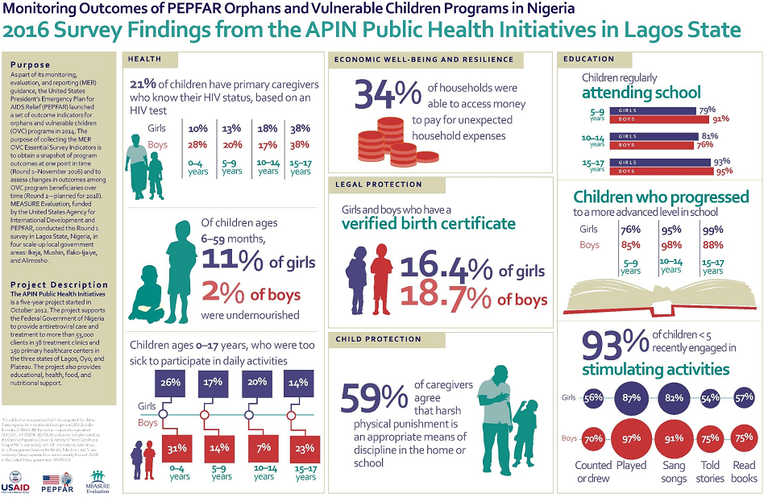Why Monitoring Project-Level Outcomes Is Important for PEPFAR Orphans and Vulnerable Children Programs
by Lisa Parker, PhD, MEASURE Evaluation
One strategy to mitigate the impacts and prevent HIV for vulnerable children is to provide community-based care and support. The United States President’s Emergency Plan for AIDS Relief (PEPFAR) is enacting such a strategy in support of orphans and vulnerable children (OVC), through a complex, multisectoral set of interventions that can improve distinct yet interrelated factors that help children thrive. Examples include factors focused on child health (including HIV), nutrition, education, and economic well-being for their caregivers—all in support of HIV epidemic control.
For PEPFAR and stakeholders to understand how these projects are performing, it is important to have data that can tell the story from the initial inputs to the final concrete results. Monitoring improvements in the many aspects of well-being for children and their households enables evidence-informed course corrections as well as guidance for setting up projects to achieve maximum impact. For too long, projects have been focused on rudimentary tracking—providing data on how many beneficiaries have been reached and which services they are receiving—and not on the sustainable impact that a project is or is not achieving. After decades of OVC programming, we are still failing to answer the question “So what?” The lack of that answer threatens a project’s accountability to its beneficiaries and PEPFAR’s accountability to taxpayers.
Many countries collect outcome indicators through the Demographic and Health Survey, Multiple Indicator Cluster Survey, Population-Based HIV Impact Assessment (PHIA), and Violence Against Children Survey. Most of these studies are conducted every five years and measure population-based estimates of outcomes that provide important data on long-term shifts. However, these surveys do not provide data on the complex needs of OVC program beneficiaries, multisectoral outcomes along the path to intended HIV outcomes, or data on the direct impact investments made are having on the lives and well-being of children and caregivers. Further, population-based surveys are expensive, and results are typically released many months―often years―after data are collected, making it difficult for projects to use them for improvements along the way.
To address the need for data on how OVC programs improve well-being, PEPFAR, with support from MEASURE Evaluation, developed a set of outcome indicators for OVC programs as well as guidance on how to collect these indicators, available here. The indicators were designated as “Essential Survey Indicators” (ESI) because PEPFAR considered them critical for tracking progress on a set of core expected outcomes. These have been measured since 2016 in 17 countries across 28 projects. MEASURE Evaluation has provided technical assistance in nine of those countries across 17 projects and has published reports and fact sheets (See Figure 1) for each of the completed studies, available here.
These outcome indicators support decisions for developing improved, evidence-informed, strategic portfolios of OVC programs and resource allocation. For example, in Nigeria, results from the five project surveys conducted there were used to revise program strategies to better align with what project recipients needed.
An implementing partner in Zimbabwe reported the ESI survey was useful because: “We used the results of the first round of essential surveys to improve…in areas that showed lower percentages on outcomes, for example, progression in school[ing] for girls as compared to boys. This actually helped [us] to improve on the indicator.”
And, in Namibia, a donor reacted to the fact that a number of children were reported to be undernourished: “Nutrition-related activities were intensified to ensure that quarterly assessments are conducted; and children requiring further support elsewhere…are referred [to] and [can] access such services.” Likewise, many donors reported using the findings in current work planning and in the development of new procurements.
These OVC beneficiary households are highly vulnerable and are a crucial population to target if we hope to reach HIV epidemic control. If we rely only on infrequent national surveys of the general population, we won’t be getting the right information at the right time to provide data required to understand if OVC programs are effectively contributing to preventing HIV and improving treatment outcomes. And, as can be seen in the three examples shared here, donors and partners are learning and improving their efforts as a result of the information gathered through this process.
Lisa Parker, PhD, is a senior technical advisor at MEASURE Evaluation, Palladium
For more information visit https://www.measureevaluation.org/our-work/ovc/monitoring-outcomes-of-pepfar-orphans-and-vulnerable-children-programs













